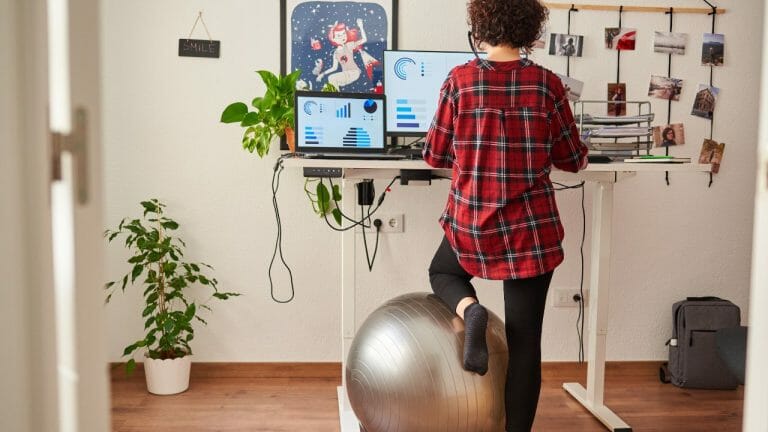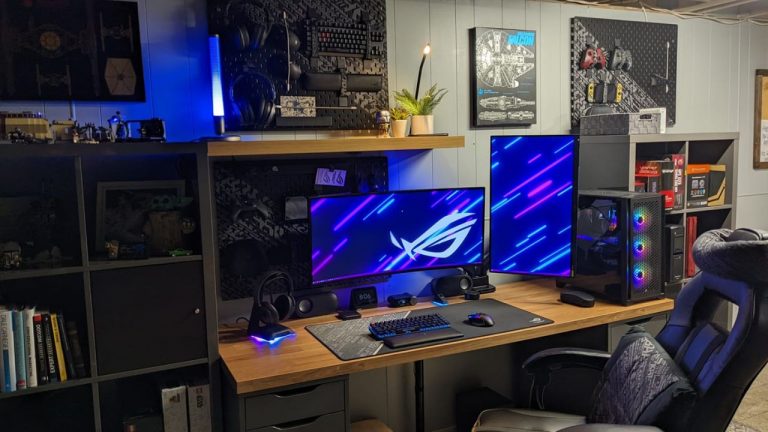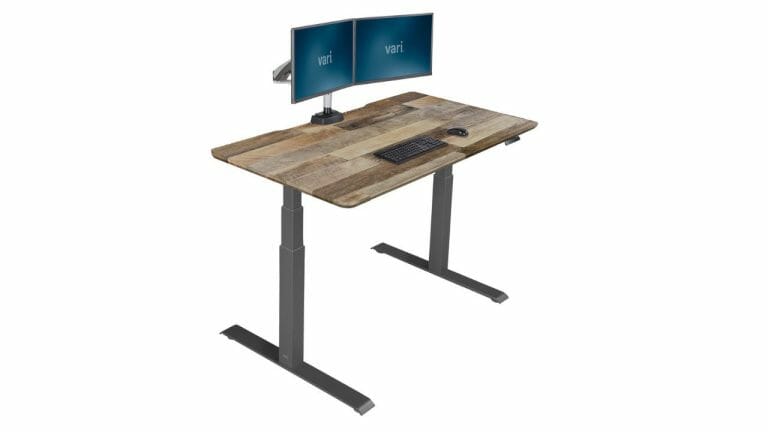Are Standing Desk Converters Worth The Money?
A standing desk can move its entire surface to any desired height. However, the sit-stand desk converter just stays on top of a pre-existing desk and can only move so far. So, are standing desk converters even worth your money?
Standing desk converters are more affordable and space-friendly. It lets you keep your old desk and still helps you enjoy the ergonomics. But it can be less sturdy than a full-fledged standing desk.
Due to an electric desk’s cost and complicated installation process, many people prefer its so-called alternative- a desk converter. But before you settle our mind, let’s see what a sit-stand desk converter has to offer.
9 Reasons You Should Invest In A Standing Desk Converter
A Sit-stand desk converter is a great alternative to electric standing desks. But it also leads to confusion when people try to select a particular option. In this case, we will take you through 10 benefits you can expect from a desk riser/converter.
1. A Small Workspace Is Fine
The biggest flex of having a desk riser is that it doesn’t require a 58 inches working space. Even if your regular desk is 36 inches, you can enjoy the ergonomics of a desk converter.
Not everybody has the intention to renovate his/her entire office. Bringing a standing desk requires a lot of space and organization. You might need to add a separate cabinet to reduce the number of stuff you put on top of the desktop.
But what if you are using a pre-existing living room/bedroom as your office? That doesn’t allow you to bring so much stuff into that particular area. A desk converter is a great choice if you face the same situation. After all, it mounts on a small part of your old desk. No extra space is necessary.
2. Affordable Price-Point
A standard electric desk can cost up to $1000. That’s not what we call budget-friendly, right? It’s even worse if you are not quite sure whether you are ready for a standing desk yet.
But a desk converter eliminates the worry entirely (even though desk risers can be costly too). The average ones are mostly below $50. There’s a huge price gap between the converters and desks.
Even if you end up hating the new work style, you don’t have much to lose. So, you can enjoy more peace of mind with a desk converter.

3. Easy To Carry Around
Sit-stand desk converters are portable. You can bring it to work with your every day. Some high-end converters are only 20 to 21 pounds. People who frequently move from one location to another for job tasks will understand its significance.
One big problem with a standing desk is its heavy weight (around 42 to 50 pounds) and bulky structure. You can only pick one place to set it up. That works if you are trying to establish an office. However, people who like flexible work-setting might be more comfortable using a portable desk converter.
4. You Can Keep The Old Desk
Does your old office desk hold special meaning to you? It might be a traditional wooden desk you got as a gift. Or, it can be just too expensive to replace. You will want to keep your old desk in either case.
A desk converter fulfills that wish for you. It enables you to modernize your desk (not replace it with a new tool). You can easily reap the benefits of a standing desk by adjusting the converter on your desk. That’s why committing to a desk riser is much easier since they don’t have to let go of anything.
5. Less Effort During Installation
Standing desk converters usually come in one piece. You just have to attach some pads and sleeve nuts if you ordered one with a keyboard tray. And the rest is simple. Pull the desktop upward while holding the stem. The desk converter easily goes to its maximum height setting. You can adjust the stem or the zig-zag legs to control its height.
As you can see, there is less room for mistakes, unlike a standing desk which arrives in different boxes and is complicated to figure out. Manufacturers always recommend having a partner during a desk installation (just so that you don’t drop it by accident). To be honest, most people neglect this advice and try to assemble the whole thing by themselves. It ultimately leads to a wobbly finish.
6. Switch Between Standing And Sitting
A desk converter allows you to change position frequently. You don’t even have to wait for the transition. Just hop on your chair and use the space surrounding your converter’s legs. It’s that easy.
If you are a photographer, tailor, or just love doing crafts for hours, this is going to be a huge plus point. For example, a sewing job requires you to stay in front of the machine all day long. If you keep sitting for such long hours, your spinal health would be at risk.
Backpains are going to be your daily companions. You can get rid of that by carrying a desk riser to your job location. Just increase the desk height every time your back feels cramped. That way, you can continue crafting, designing, or sewing for hours without any negative health impact. Isn’t that great!!
7. Appropriate In A Full-Fledged Office Setting
If we are being realistic, it really becomes tough to renovate your cubicle at work. It’s even awkward if no one (other than you) is interested in a standing desk at your office. Plus, companies hardly incur such big costs for their employees. They will probably just hand you a back pillow in an attempt to compensate for your back pain.
However, convincing your boss to provide desk converters will be a bit easier. First of all, it doesn’t require throwing the old desks out (as we mentioned earlier). Plus, it costs less than $30 if you are okay with a basic piece.
Moreover, if you are in charge of renovating your work area, it will be cheaper to get a desk converter.
8. Raises Just Part Of The Desk
When it comes to carrying heavy-weight equipment, regular desks do it better. Yes, it’s true. Ergonomic desks give you all the flexibility you need in the world. But there’s a strict weight limit you have to follow. And, sometimes, the desk starts shaking even though you are under its max weight capacity. That’s why many users don’t feel safe putting precious gadgets like a monitor, printers, or other costly items on an ergonomic desk.
But a desk converter takes you out of such a dilemma. It raises just part of the desk. You are not raising the entire desk surface. Instead a part of the desk (which is the converter itself) rises along with some mandatory stuff you need while standing.
So, even if you have a lot of equipment on your office desk, there’s no risk of major accidents. You can just keep one or two items on the converter. The rest of your office items are safe on the non-ergonomic part of your desk. That’s a huge relief.
9. You Can Work From Anywhere
Employees are slowly inclining towards remote working positions. One major reason is that sitting in a cubicle for eight long hours is physically and mentally straining.
You see, it’s not just about an ergonomic desk; it’s about the locations too. With a sit-stand desk converter, you can move around your house or studio. Suppose you want to see a presentation while eating in your kitchen. You can carry the desk converter with you and place it on top of the kitchen table.
Need some sunlight? Take the desk riser to your living room. Just like that, you don’t have to fix one particular place as your office. It can be anywhere around the house. As long as you have a desk converter, you are good to go.

4 Disadvantages Of Using A Standing Desk Converter
Since we are here judging a desk converter, we have to show both sides. Unfortunately, there are some minor inconveniences you have to face. Take a look.
1. Reduce Your Desk-Space While Standing
Do you like space regardless of your desk height? If yes, you might have a hard time adjusting to a standing desk converter. Once the convertible desk is at its minimum height (it means you are sitting), you have the entire desk surface to use. You can write, type, place your hand comfortably, and so on.
Once the desk converter starts rising, the desk space is divided into two parts. Your working space becomes limited to a small surface higher than the rest of the desk. There are only a few things you can place here. Want to rest your hands on the desktop? Not a good idea. You might knock something over and damage it.
2. No Cable Management
Cable management is a huge headache whether you work with a standing desk or just a desk riser. You are still going to need every electronic equipment like before. But one plus point of a standard electric desk is its separate compartment for managing cables. It is usually under the desktop. Having a good cable management system reduces the chances of tripping and falling.
However, a desk converter normally doesn’t come with this premium feature. You have to rely on DIY techniques to build one for yourself.
3. Wobbles A Bit When You Type
Desk riser/converter has less capacity to be stable at a higher position. The more you increase its height, the less sturdy it feels. If you have used a standing desk before, you will notice the wobbliness in a heartbeat.
What happens is, full-fledged desks come with strong motors, lifting columns and a heavy desktop. Naturally, the weight capacity goes around 275 to 300 pounds.
But desk converters are intentionally kept lightweight. So that, it’s easier for you to move around. However, it costs you the stability and sturdiness. You can still place one or two monitors on it without much consideration. But if you try to load it too much, it will shake noticeably.
4. Not Much Ergonomics To Use While Sitting
You get the best results from a convertible desk if the non-ergonomic desk matches your sitting height perfectly. Regular office desks are created keeping a standard height in mind. So, there is a big possibility you will find it either higher or lower than your ideal sitting height.
A desk riser can’t solve this issue for you. It can’t make the desk go below its original height. It’s possible to adjust the desk converter to your standing height. But this ergonomics doesn’t come in handy when you are sitting. Because there’s a limit to how much it can be lowered due to the pre-existing desk or any other surface.
Before You Go…
Sit-stand desk riser or an electric desk are not the only two options you have got. If you don’t like a shaking platform for your monitors, go ahead and get a monitor stand. You can mount it on top of your non-ergonomic desk. If you want to know more, here’s our assessment of whether a dual monitor stand is necessary or not.





![Standing Desk Vs Treadmill Desk [Which One’s Better]](https://homethereby.com/wp-content/uploads/2023/02/Standing-Desk-Vs-Treadmill-Desk-768x432.jpg)
